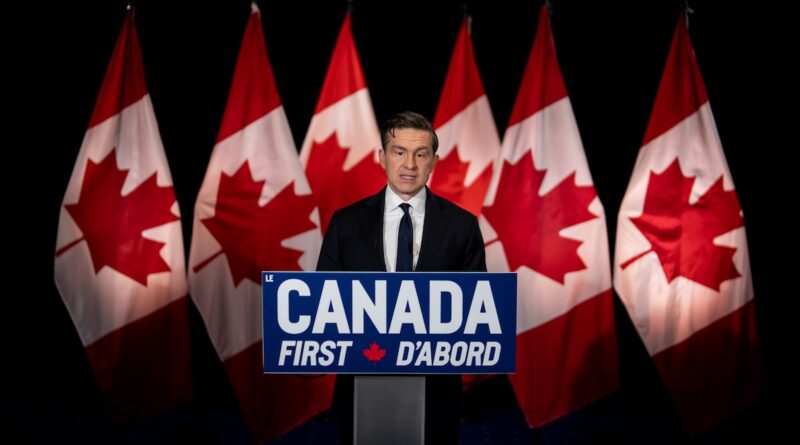Poilievre pledges Arctic military base, naval icebreakers if party forms government
Conservative Leader Pierre Poilievre speaks during a news conference in Vancouver, on Feb. 3.ETHAN CAIRNS/The Canadian Press
Conservative Leader Pierre Poilievre is pledging, if his party forms government, to build a military base in Canada’s Arctic, buy two polar icebreakers for the Royal Canadian Navy and double the size of the Canadian Rangers patrol group responsible for upper reaches of the North.
Mr. Poilievre is scheduled to unveil this pledge Monday morning in the Arctic city of Iqaluit.
In a Conservative press statement obtained by The Globe and Mail, Mr. Poilievre cites the need to counter “growing threats from China and Russia” for these measures – as well as maintaining good relations with the United States.
“Our safety, territory and trade with the U.S. requires we take back control of Canada’s North,” Mr. Poilievre said, adding that Beijing is trying to gain a foothold in the Arctic despite no territory fronting the region.
“Hostile powers want our resources and shipping routes, and to be within striking distance of our continent. China has now declared itself a ‘near-Arctic state,’ even though its borders are approximately 1,500 kilometres from the Arctic Circle,” the Conservative statement says.
Canada currently does not have a military base in the Arctic – the definition of what constitutes a base is variable – but the Forces do have a number of stations or installations across the region.
U.S. President Donald Trump has repeatedly criticized Canada’s defence spending. In January, before taking office, he said Canada, which this fiscal year is spending more than $40-billion on its military, should pay the United States for defending it “They have a very small military. They rely on our military. It’s all fine, but they’ve got to pay for that,” he said at a Jan. 7 press conference.
Mr. Poilievre is pledging to fund his promises by making significant cuts to foreign aid – a means of finding more dollars for defence that he first mentioned in 2024. A Conservative government, the press statement says, would “dramatically cut foreign aid, much of which goes to dictators, terrorists and global bureaucracies.” Examples his office provided last year would include assistance to the United Nations Relief and Works Agency for Palestine Refugees and Canada’s stake in the controversial Chinese-led Asian Infrastructure Investment Bank.
The Conservatives say the military base they envision in Iqaluit would be able to host a full Royal Canadian Air Force wing, or unit of command, to launch and land new F-35 fighter jets to deter, intercept and destroy threats as well as to land Poseidon P-8 surveillance aircraft that carry out search and rescue, conduct anti-submarine warfare, as well as intelligence, surveillance and reconnaissance work.
Iqaluit is already home to a Forward Operating Location for North American Aerospace Defence Command: an as-needed deployment facility including an aircraft hangar. The city also has a civilian airport and seaport.
The two Navy icebreakers the Conservatives are promising would be on top of the two polar icebreakers the Seaspan and Davie shipyards are now building for the Canadian Coast Guard. Mr. Poilievre is pledging these existing icebreakers will be delivered by 2029.
It’s not clear by what year the Conservative’s two promised naval icebreakers will be ready or what ice-breaking capacity they would have.
The Canadian Rangers are lightly armed reservists in remote, isolated and coastal regions of Canada. They keep a lookout for unusual activity, assist in search and rescue, provide guide services to other Canadian Armed Forces members and help with disaster relief and community support. There are five patrol groups together numbering approximately 5,000 across the regions.
Mr. Poilievre is pledging to double the size of the 1st Patrol Group of the Canadian Rangers, expanding it from 2,000 to 4,000 Rangers. This group is spread across the northernmost parts of Canada including Nunavut, Yukon, Northwest Territories and Atlin, B.C.
In 2022, Canada’s then-top soldier General Wayne Eyre warned that Canada’s “tenuous hold” on its Arctic territories will come under increasing challenge in the decades ahead as China and Russia expand their presence in the region.
Russia has been reopening Arctic military bases and outposts for years. China is also securing a significant presence in the Arctic as Russia, facing a severe budget crunch from its military assault on Ukraine, increasingly relies on Beijing and unprecedented levels of Chinese corporate and state investment to develop the northern region.
Among Canada’s current installations across the region is Canadian Forces Station Alert, on the northern tip of Ellesmere Island. It is a listening post that collects signals intelligence and has more than 50 full-time military and civilian personnel. It can also help with search and rescue and supports climate-change research.
Ottawa is also upgrading infrastructure at four forward operating locations in the North: Inuvik, NWT, Yellowknife, Iqaluit and Goose Bay, N.L., including runway modifications, hangars, operations facilities, accommodations and telecommunication facilities. They are intended to support rapid deployment in the region.
There is a naval refuelling facility under development at Nanisivik on Baffin Island, Nunavut, and Joint Task Force North has a headquarters in Yellowknife responsible for all Canadian Armed Forces operations and administration in northern Canada. Yellowknife is not however in the High Arctic like Iqaluit.
Canada’s military presence in the North is to a significant extent comprised of annual training and exercise operations, which require the Forces to move assets and troops from southern Canada for the duration.

